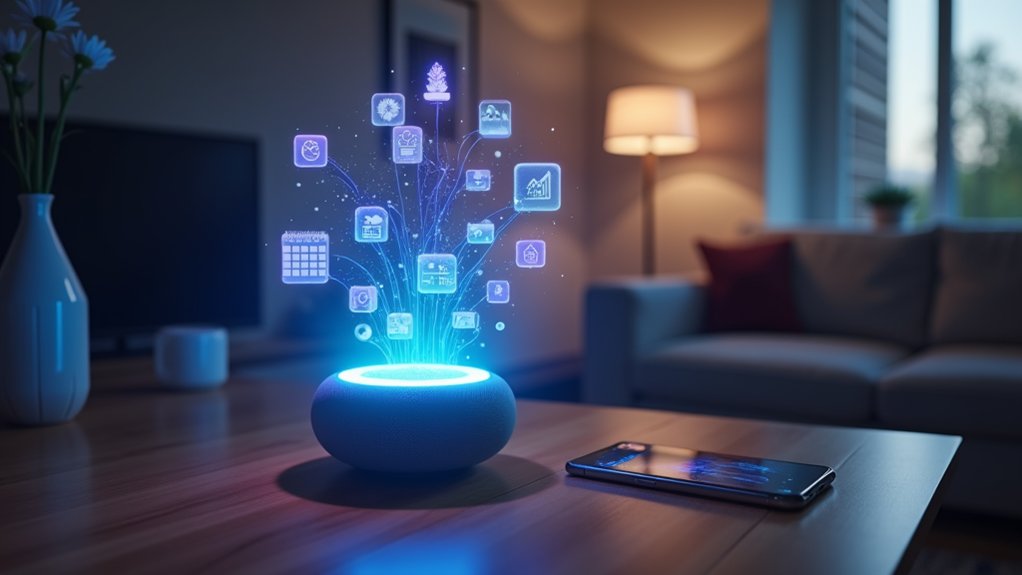What Is an Artificial Intelligence Assistant and How Does It Work?
An artificial intelligence assistant is a software program that uses natural language processing, machine learning, and data amalgamation to automate tasks and provide information. These digital tools interpret user inputs, adapt to preferences over time, and respond with relevant information or actions. AI assistants operate through internet-connected devices to perform functions ranging from controlling smart home devices to answering questions, scheduling appointments, and offering specialized analysis. Further exploration reveals their expanding capabilities across personal and professional domains.

Since technology continues to advance at an unprecedented pace, Artificial Intelligence (AI) Assistants have emerged like transformative tools that seamlessly combine into both personal and professional environments. These sophisticated systems primarily function to automate tasks and provide information through a combination of natural language processing (NLP), machine learning (ML), and data amalgamation technologies that enable human-like interactions.
AI Assistants manifest in several key forms, including virtual personal assistants like Siri and Alexa, enterprise solutions that streamline corporate workflows, customer service chatbots, and specialized tools designed for specific domains like financial analysis or content creation. These assistants are typically cloud-based systems that require internet-connected devices to function properly.
Today’s AI Assistants range from Siri to enterprise solutions, serving as versatile tools across personal, corporate and specialized domains.
The operational framework of AI Assistants relies on complex technological infrastructure. At their foundation, these systems employ NLP to interpret and contextualize user inputs, whether delivered through text or voice commands. Machine learning algorithms continuously analyze interaction patterns, enabling the assistant to adapt to user preferences and improve response accuracy over time. These systems utilize speech recognition technology to effectively convert voice inputs into text for processing, accommodating diverse accents and speech patterns.
API amalgamation serves as the bridge connecting these assistants to external applications and data sources, streamlining actions within established workflows and providing access to real-time information. Through advanced sentiment analysis capabilities, these assistants can detect emotional tones in user inputs and adjust responses accordingly.
The practical applications of AI Assistants span diverse contexts. In personal settings, they control smart home devices, manage calendars, and deliver news or weather updates. Business implementations focus on automating repetitive tasks like scheduling meetings, answering internal queries, and streamlining HR processes.
Many organizations deploy customer-facing AI chatbots to handle routine inquiries, reducing support backlogs and reserving human intervention for complex issues. These assistants also play increasingly important roles in specialized fields, offering investment guidance, editing written content, and performing domain-specific functions in areas like healthcare or legal research.
With these systems continuing to adapt, their ability to process natural language, learn from interactions, and combine across platforms positions them as increasingly valuable productivity tools. Through cloud processing capabilities and sophisticated conversational interfaces, AI Assistants effectively bridge the gap between human communication patterns and computational efficiency, transforming how individuals and organizations approach routine tasks and information management.
Frequently Asked Questions
Can AI Assistants Develop Their Own Biases?
AI assistants can develop biases through multiple mechanisms: inheriting prejudices from biased training datasets, enhancing existing societal inequities through algorithmic patterns, learning from skewed user interactions, and developing proxy discriminations through feature correlations.
These biases manifest in discriminatory outputs, gender stereotyping, and unequal performance across demographic groups.
Mitigation remains challenging since correction efforts may inadvertently suppress legitimate discourse or create new forms of bias through overly restrictive guardrails.
What Privacy Concerns Arise When Using AI Assistants?
Privacy concerns with AI assistants include massive data accumulation, often without explicit consent, creating extensive personal profiles.
These systems collect voice commands, browsing histories, and sometimes healthcare or financial information through opaque processes.
Security vulnerabilities enable potential data breaches and cyberattacks.
Certain demographics, particularly elderly users, face disproportionate risks due to limited digital literacy.
Regulatory frameworks frequently lag behind rapidly evolving AI data harvesting practices, leaving users with inadequate protections.
How Do Companies Train Their AI Assistants?
Companies train AI assistants through multiple complementary approaches.
They utilize generative AI tools to create diverse training content, implement adaptive learning systems that personalize experiences, employ human-in-the-loop methodology where experts validate outputs and correct errors, and deploy strengthening strategies including spaced repetition and scenario-based learning.
This thorough training framework guarantees assistants develop accurate knowledge representation while continuously improving through feedback cycles and real-world application data.
Will AI Assistants Replace Certain Human Jobs?
AI assistants are poised to replace jobs involving repetitive mental work, particularly in administrative and customer service sectors where 46% of tasks are highly vulnerable to automation.
Research indicates 14% of workers globally have already been displaced, with routine tasks in major economies projected for complete automation by 2030.
While 69 million new positions may emerge following the transition, approximately 83 million jobs could disappear within five years, necessitating significant workforce retraining.
Can AI Assistants Work Without Internet Connection?
AI assistants can function without internet connection through on-device processing technologies.
Local AI models operate independently using device resources and internal file systems, eliminating cloud dependencies.
These offline-capable assistants process data locally, maintain privacy through containment protocols, and support various functions including document analysis and voice interactions.
Implementation requires sufficient computational capacity, proper model selection, and dedicated management interfaces to facilitate seamless operation irrespective of connectivity status.